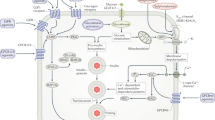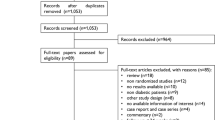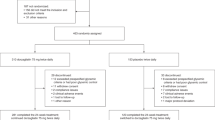Abstract
The potential cardiovascular risks that are associated with drugs for type 2 diabetes have recently raised considerable clinical and regulatory concerns. As some risk factors for cardiovascular disease and type 2 diabetes are related, identifying agents that target shared underlying pathways and processes is an attractive therapeutic strategy. In this article, we review the background to and the implications of recent regulatory guidance on the development of new drugs for diabetes, and discuss the potential cardiovascular effects of selected classes of diabetes drugs that are currently being investigated.
This is a preview of subscription content, access via your institution
Access options
Subscribe to this journal
Receive 12 print issues and online access
$209.00 per year
only $17.42 per issue
Buy this article
- Purchase on Springer Link
- Instant access to full article PDF
Prices may be subject to local taxes which are calculated during checkout

Similar content being viewed by others
References
Gu, K., Cowie, C. C. & Harris, M. I. Diabetes and decline in heart disease mortality in US adults. JAMA 281, 1291–1297 (1999).
Nathan, D. M. et al. Intensive diabetes treatment and cardiovascular disease in patients with type 1 diabetes. N. Engl. J. Med. 353, 2643–2653 (2005).
Gore, M. O. & McGuire, D. K. The 10-year post-trial follow-up of the United Kingdom Prospective Diabetes Study (UKPDS): cardiovascular observations in context. Diab. Vasc. Dis. Res. 6, 53–55 (2009).
Holman, R. R. et al. 10-year follow-up of intensive glucose control in type 2 diabetes. N. Engl. J. Med. 359, 1577–1589 (2008).
Patel, A. et al. Intensive blood glucose control and vascular outcomes in patients with type 2 diabetes. N. Engl. J. Med. 358, 2560–2572 (2008).
Duckworth, W. et al. Glucose control and vascular complications in veterans with type 2 diabetes. N. Engl. J. Med. 360, 129–139 (2009).
Gerstein, H. C. et al. Effects of intensive glucose lowering in type 2 diabetes. N. Engl. J. Med. 358, 2545–2559 (2008).
Fisman, E. Z., Motro, M. & Tenenbaum, A. Non-insulin antidiabetic therapy in cardiac patients: current problems and future prospects. Adv. Cardiol. 45, 154–170 (2008).
Inzucchi, S. E. & McGuire, D. K. New drugs for the treatment of diabetes: part II: Incretin-based therapy and beyond. Circulation 117, 574–584 (2008).
Effect of intensive blood-glucose control with metformin on complications in overweight patients with type 2 diabetes (UKPDS 34). UK Prospective Diabetes Study (UKPDS) Group. Lancet 352, 854–865 (1998).
Holman, R. Metformin as first choice in oral diabetes treatment: the UKPDS experience. Journ. Annu. Diabetol. Hotel Dieu 13–20 (2007).
Howes, L. G. Cardiovascular effects of sulphonylureas: role of K(ATP) channels. Diabetes Obes. Metab. 2, 67–73 (2000).
Charles, M. A. Intensive insulin treatment in type 2 diabetes. Diabetes Technol. Ther. 7, 818–822 (2005).
Erdmann, E. et al. PROactive 07: pioglitazone in the treatment of type 2 diabetes: results of the PROactive study. Vasc. Health Risk Manag. 3, 355–370 (2007).
Nissen, S. E. and Wolski, K. Effect of rosiglitazone on the risk of myocardial infarction and death from cardiovascular causes. N. Engl. J. Med. 356, 2457–2471 (2007).
Doggrell, S. A. Muraglitazar: beneficial or detrimental in the treatment of type 2 diabetes? Expert Opin. Pharmacother. 7, 1229–1233 (2006).
Shoelson, S. E., Lee, J. & Goldfine, A. B. Inflammation and insulin resistance. J. Clin. Invest. 116, 1793–1801 (2006).
Kovesdy, C. P. & Kalantar-Zadeh, K. Novel targets and new potential: developments in the treatment of inflammation in chronic kidney disease. Expert Opin. Investig. Drugs 17, 451–67 (2008).
Tousoulis, D., Charakida, M. & Stefanadis, C. Endothelial function and inflammation in coronary artery disease. Postgrad. Med. J. 84, 368–371 (2008).
Balint, B. L. & Nagy, L. Selective modulators of PPAR activity as new therapeutic tools in metabolic diseases. Endocr. Metab. Immune Disord. Drug Targets 6, 33–43 (2006).
Nikolaidis, L. A. et al. Effects of glucagon-like peptide-1 in patients with acute myocardial infarction and left ventricular dysfunction after successful reperfusion. Circulation 109, 962–965 (2004).
Sokos, G. G. et al. Effect of glucagon-like peptide-1 (GLP-1) on glycemic control and left ventricular function in patients undergoing coronary artery bypass grafting. Am. J. Cardiol. 100, 824–829 (100).
Sokos, G. G. et al. Glucagon-like peptide-1 infusion improves left ventricular ejection fraction and functional status in patients with chronic heart failure. J. Card. Fail. 12, 694–699 (2006).
Nikolaidis, L. A. et al. Glucagon-like peptide-1 limits myocardial stunning following brief coronary occlusion and reperfusion in conscious canines. J. Pharmacol. Exp. Ther. 312, 303–308 (2005).
Basu, A. et al. Beneficial effects of GLP-1 on endothelial function in humans: dampening by glyburide but not by glimepiride. Am. J. Physiol. Endocrinol. Metab. 293, E1289–E1295 (2007).
Ban, K. et al. Cardioprotective and vasodilatory actions of glucagon-like peptide 1 receptor are mediated through both glucagon-like peptide 1 receptor-dependent and -independent pathways. Circulation 117, 2340–2350 (2008).
Cabou, C. et al. Brain glucagon-like peptide-1 regulates arterial blood flow, heart rate, and insulin sensitivity. Diabetes 57, 2577–2587 (2008).
Idris, I. & Donnelly, R. Sodium-glucose co-transporter-2 inhibitors: an emerging new class of oral antidiabetic drug. Diabetes Obes. Metab. 11, 79–88 (2009).
Ikari, A. et al. Recovery from heat shock injury by activation of Na+-glucose cotransporter in renal epithelial cells. Biochim. Biophys. Acta 1643, 47–53 (2003).
Arakawa, K. et al. Improved diabetic syndrome in C57BL/KsJ-db/db mice by oral administration of the Na+-glucose cotransporter inhibitor T-1095. Br. J. Pharmacol. 132, 578–586 (2001).
Vemula, S. et al. A functional role for sodium-dependent glucose transport across the blood-brain barrier during oxygen glucose deprivation. J. Pharmacol. Exp. Ther. 328, 487–495 (2009).
Zhou, L. et al. Human cardiomyocytes express high level of Na+/glucose cotransporter 1 (SGLT1). J. Cell. Biochem. 90, 339–346 (2003).
Davies, M. J., Post-prandial hyperglycaemia and prevention of cardiovascular disease. Diabet. Med. 22, S6–S9 (2005).
Tilg, H. & Moschen, A. R. Inflammatory mechanisms in the regulation of insulin resistance. Mol. Med. 14, 222–231 (2008).
Ahn, K. S., Sethi, G. & Aggarwal, B. B. Nuclear factor-kappa B: from clone to clinic. Curr. Mol. Med. 7, 619–637 (2007).
Schreiber, S. Activation of nuclear factor kappaB as a target for anti-inflammatory therapy. Gut 44, 309–310 (1999).
Fleischman, A. et al. Salsalate improves glycemia and inflammatory parameters in obese young adults. Diabetes Care 31, 289–294 (2008).
Sauter, N. S. et al. The antiinflammatory cytokine interleukin-1 receptor antagonist protects from high-fat diet-induced hyperglycemia. Endocrinology 149, 2208–2218 (2008).
Fearon, W. F. & Fearon, D. T. Inflammation and cardiovascular disease: role of the interleukin-1 receptor antagonist. Circulation 117, 2577–2579 (2008).
Ikonomidis, I. et al. Inhibition of interleukin-1 by anakinra improves vascular and left ventricular function in patients with rheumatoid arthritis. Circulation 117, 2662–2669 (2008).
Haigis, M. C. & Guarente, L. P. Mammalian sirtuins — emerging roles in physiology, aging, and calorie restriction. Genes Dev. 20, 2913–2921 (2006).
Milne, J. C. et al. Small molecule activators of SIRT1 as therapeutics for the treatment of type 2 diabetes. Nature 450, 712–716 (2007).
Yoshizaki, T. et al. SIRT1 exerts anti-inflammatory effects and improves insulin sensitivity in adipocytes. Mol. Cell. Biol. 29, 1363–1374 (2008).
Ota, H. et al. Sirt1 modulates premature senescence-like phenotype in human endothelial cells. J. Mol. Cell Cardiol. 43, 571–579 (2007).
Zhang, Q. J. et al. Endothelium-specific overexpression of class III deacetylase SIRT1 decreases atherosclerosis in apolipoprotein E-deficient mice. Cardiovasc. Res. 80, 191–199 (2008).
Rush, J. W. et al. Chronic resveratrol enhances endothelium-dependent relaxation but does not alter eNOS levels in aorta of spontaneously hypertensive rats. Exp. Biol. Med. 232, 814–822 (2007).
Potente, M. & Dimmeler, S. Emerging roles of SIRT1 in vascular endothelial homeostasis. Cell Cycle 7, 2117–2122 (2008).
Atanasov, A. G. & Odermatt, A. Readjusting the glucocorticoid balance: an opportunity for modulators of 11beta-hydroxysteroid dehydrogenase type 1 activity? Endocr. Metab. Immune Disord. Drug Targets 7, 125–140 (2007).
Su, X. et al. Discovery of novel inhibitors of human 11beta-hydroxysteroid dehydrogenase type 1. Mol. Cell. Endocrinol. 301, 169–173 (2008).
Hermanowski-Vosatka, A. et al. 11beta-HSD1 inhibition ameliorates metabolic syndrome and prevents progression of atherosclerosis in mice. J. Exp. Med. 202, 517–527 (2005).
Higgins, L. S. & Mantzoros, C. S. The development of INT131 as a selective PPARγ modulator: approach to a safer insulin sensitizer. 26 Aug 2008 (doi:10.1155/2008/936906).
Nissen, S. E., Wolski, K. & Topol, E. J. Effect of muraglitazar on death and major adverse cardiovascular events in patients with type 2 diabetes mellitus. JAMA 294, 2581–2586 (2005).
Donnelly, R. Effect of pioglitazone on the drivers of cardiovascular risk in type 2 diabetes. Int. J. Clin. Pract. 61, 1160–1169 (2007).
Forst, T. et al. Investigation of the vascular and pleiotropic effects of atorvastatin and pioglitazone in a population at high cardiovascular risk. Diab. Vasc. Dis. Res. 5, 298–303 (2008).
Borboni, P. et al. Molecular and functional characterization of pituitary adenylate cyclase-activating polypeptide (PACAP-38)/vasoactive intestinal polypeptide receptors in pancreatic beta-cells and effects of PACAP-38 on components of the insulin secretory system. Endocrinology 140, 5530–5537 (1999).
Nakata, M. & Yada, T. PACAP in the glucose and energy homeostasis: physiological role and therapeutic potential. Curr. Pharm. Des. 13, 1105–1112 (2007).
Dvorakova, M. C. Cardioprotective role of the VIP signaling system. Drug News Perspect. 18, 387–391 (2005).
Winzell, M. S. & Ahren, B. G-protein-coupled receptors and islet function — implications for treatment of type 2 diabetes. Pharmacol. Ther. 116, 437–448 (2007).
Gardiner, S. M. et al. Regional haemodynamic responses to pituitary adenylate cyclase-activating polypeptide and vasoactive intestinal polypeptide in conscious rats. Br. J. Pharmacol. 111, 589–597 (1994).
Dvorakova, M. C. et al. Down-regulation of vasoactive intestinal peptide and altered expression of its receptors in rat diabetic cardiomyopathy. Cell Tissue Res. 323, 383–393 (2006).
Pacher, P. et al. Modulation of the endocannabinoid system in cardiovascular disease: therapeutic potential and limitations. Hypertension 52, 601–607 (2008).
Mach, F. & Steffens, S. The role of the endocannabinoid system in atherosclerosis. J. Neuroendocrinol. 20, S53–S57 (2008).
Viveros, M. P. et al. Critical role of the endocannabinoid system in the regulation of food intake and energy metabolism, with phylogenetic, developmental, and pathophysiological implications. Endocr. Metab. Immune Disord. Drug Targets 8, 220–230 (2008).
Sugamura, K. et al. Activated endocannabinoid system in coronary artery disease and antiinflammatory effects of cannabinoid 1 receptor blockade on macrophages. Circulation 119, 28–36 (2009).
Nissen, S. E. et al. Effect of rimonabant on progression of atherosclerosis in patients with abdominal obesity and coronary artery disease: the STRADIVARIUS randomized controlled trial. JAMA 299, 1547–1560 (2008).
Mitchell, P. B. & Morris, M. J. Depression and anxiety with rimonabant. Lancet 370, 1671–1672 (2007).
Grimsby, J., Berthel, S. J. & Sarabu, R. Glucokinase activators for the potential treatment of type 2 diabetes. Curr. Top. Med. Chem. 8, 1524–1532 (2008).
Kodra, J. T. et al. Novel glucagon receptor antagonists with improved selectivity over the glucose-dependent insulinotropic polypeptide receptor. J. Med. Chem. 51, 5387–5396 (2008).
Kaidanovich-Beilin, O. & Eldar-Finkelman, H. Long-term treatment with novel glycogen synthase kinase-3 inhibitor improves glucose homeostasis in ob/ob mice: molecular characterization in liver and muscle. J. Pharmacol. Exp. Ther. 316, 17–24 (2006).
Gupta, S. K. et al. Improvement in HIV-related endothelial dysfunction using the anti-inflammatory agent salsalate: a pilot study. AIDS 22, 653–655 (2008).
Author information
Authors and Affiliations
Corresponding author
Ethics declarations
Competing interests
The research of V.F. at Tulane University is supported by grants from GlaxoSmithKline, Novartis, Novo–Nordisk, Takeda, Astra–Zeneca, Pfizer, Sanofi–Aventis, Eli Lilly, Daiichi–Sankyo, the National Institutes of Health and the American Diabetes Association.
V.F. has received honoraria for consulting and lectures from GlaxoSmithKline, Novartis, Takeda, Pfizer, Sanofi–Aventis and Eli Lilly.
Related links
Related links
FURTHER INFORMATION
Rights and permissions
About this article
Cite this article
DeSouza, C., Fonseca, V. Therapeutic targets to reduce cardiovascular disease in type 2 diabetes. Nat Rev Drug Discov 8, 361–367 (2009). https://doi.org/10.1038/nrd2872
Issue Date:
DOI: https://doi.org/10.1038/nrd2872
This article is cited by
-
The sodium glucose cotransporter 2 inhibitor empagliflozin does not prolong QT interval in a thorough QT (TQT) study
Cardiovascular Diabetology (2013)
-
Network-Based Approaches in Drug Discovery and Early Development
Clinical Pharmacology & Therapeutics (2013)
-
Safety, Tolerability, Pharmacokinetics, and Pharmacodynamics of Multiple Rising Doses of Empagliflozin in Patients with Type 2 Diabetes Mellitus
Diabetes Therapy (2013)
-
Neue Medikamente
Der Diabetologe (2013)
-
Legacy Effects from DCCT and UKPDS: What They Mean and Implications for Future Diabetes Trials
Current Atherosclerosis Reports (2010)



